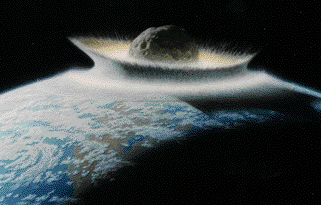Near miss or normal?
An asteroid scare made the papers again recently, when journalists reported that the asteroid QQ47, a 1.2 km wide chunk of rock, had a 1 in 900,000 chance of colliding with the earth in 2014. But it only took 2 days - a blink of an eye in cosmological terms but an aeon in the world of newspapers - for astronomers to refine their predictions and show for certain that the collision was not going to happen after all.
So was it the papers' fault for sensationalising a valid story, or was the problem caused by the way the risk was initially presented? Should the information have been released so soon, or should astronomers have waited till they were more sure of their facts? And just how seriously should we take the next "deep impact" story when it appears in the paper?

A real risk or just scare tactics? (Painting by Donald E. Davis, courtesy of NASA)
Most astronomers agree that information on Near Earth Objects (NEOs) should be made publicly available, but also recognise that after many scare stories in the papers there needs to be a better way of communicating the risks to the public. In 1999, Richard Binzel from MIT proposed the Torino scale for NEO impact risks, hoping that it would help convey the magnitude of these risks to the general public and press, just as the Richter scale does for earthquakes.
The Torino scale rates each NEO on a scale from 0 to 10, where 0 means there is no risk it will collide with Earth, either because it is too small to make it through the atmosphere or because it is definitely not on a collision course, and 8, 9 and 10 mean collision is certain with local, regional or global consequences respectively.
To calculate an NEO's rating, astronomers use its kinetic energy (its mass multiplied by the square of its velocity) and the probability that the object will indeed collide with earth. When an NEO is first examined, these values must be crudely approximated. The mass is usually estimated from the object's observed brightness, and the velocity and probability of collision from the observed arc of its path through space. As more observations are made, these figures are refined and a more accurate assessment of the object's rating on the Torino scale can be made. (For more information on calculating impact risks see NEO Program.)
So even if an object starts at 1 or higher on the Torino scale, it is highly likely that it will be downgraded as more data becomes available. In fact, a Torino score of 1 is the highest that has so far been assigned to any NEO, and all but one of these were subsequently downgraded to 0.
The wording of the scale says that a rating of 1 "merits careful monitoring", but such objects are only of real interest to astronomers. The rest of us should only worry about NEOs rated higher than 1. "Nobody should lose sleep over an asteroid in the zero or one category," says Binzel. He thinks the solution to the problem of false alarms in the press is to change the description of a category 1 NEO to Normal to reflect this.
Other astronomers feel that the scale should reflect how long the object has been monitored for, in order to give some indication of how accurate we can expect the measurements to be. However, there are some who feel that any sort of "scare scale" is unhelpful, and that the rating system should be dumped altogether.
One significant problem with the Torino scale is that we have no relevant benchmarks. Earthquakes rated 6 or even 8 on the Richter scale occur annually, putting earthquakes lower down on the scale in some perspective. We can be thankful that we have not as yet had any NEOs with a high rating on the Torino scale, but the flip side is that we find it difficult to put a score of 0 or a 1 in context.
So when the next asteroid scare hits the papers, with an NEO rated 1 on the Torino scale, remember that it is just another normal day at the cosmological office, but probably a slow news day at the paper's.